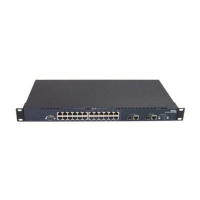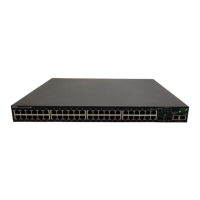BigIron RX Series Configuration Guide 1079
53-1002253-01
Chapter
42
IPv6 Addressing
This chapter includes overview information about the following topics:
• IPv6 addressing.
• The IPv6 stateless autoconfiguration feature, which enables a host on a local link to
automatically configure its interfaces with new and globally unique IPv6 addresses associated
with its location.
IPv6 addressing
A limitation of IPv4 is its 32-bit addressing format, which is unable to satisfy potential increases in
the number of users, geographical needs, and emerging applications. To address this limitation,
IPv6 introduces a new 128-bit addressing format.
An IPv6 address is composed of 8 fields of 16-bit hexadecimal values separated by colons (:).
Figure 143 shows the IPv6 address format.
FIGURE 143 IPv6 address format
As shown in Figure 143, HHHH is a 16-bit hexadecimal value, while H is a 4-bit hexadecimal value.
The following is an example of an IPv6 address.
2001:0000:0000:0200:002D:D0FF:FE48:4672
Note that the sample IPv6 address includes hexadecimal fields of zeros. To make the address less
cumbersome, you can do the following:
• Omit the leading zeros; for example, 2001:0:0:200:2D:D0FF:FE48:4672.
• Compress the successive groups of zeros at the beginning, middle, or end of an IPv6 address
to two colons (::) once per address; for example, 2001::200:2D:D0FF:FE48:4672.
When specifying an IPv6 address in a command syntax, keep the following in mind:
• You can use the two colons (::) once in the address to represent the longest successive
hexadecimal fields of zeros.
• The hexadecimal letters in the IPv6 addresses are not case-sensitive.
As shown in Figure 143, the IPv6 network prefix is composed of the left-most bits of the address.
As with an IPv4 address, you can specify the IPv6 prefix using the <prefix>/<prefix-length> format,
where the following applies.
Network Prefix
Interface ID
HHHH = Hex Value 0000 – FFFF
128 Bits
HHHH
HHHH HHHH HHHH HHHH HHHH HHHH HHHH

